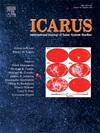Accreted volatiles influence low-temperature rock equilibria on Europa
IF 2.5
2区 物理与天体物理
Q2 ASTRONOMY & ASTROPHYSICS
引用次数: 0
Abstract
The subsurface ocean of Europa has been identified as a high-priority target in the search for habitable environments beyond Earth. Determining the chemical composition of Europa's ocean, a result of water-rock interaction in Europa's interior, is essential to understanding the moon's geological history and whether it can support life. In this study, we used a thermochemical computer modelling code (CHIM-XPT) to explore the range of potential ocean compositions that could result from water-rock interactions at the ocean-silicate interface immediately following the formation of the ocean. We modelled a range of plausible silicate starting materials (based on CV, L and LL chondritic material) and endmember accreted ice compositions (pure H2O vs. cometary) that could have contributed to the volatile inventory of Europa. These models assume a water/layer of its current size and do not incorporate compositional changes resulting from further processes (e.g., ice sheet formation) or additional sources of material (e.g., micrometeorite impacts). Our results show that the initial composition of volatiles had a stronger influence on the resulting ocean composition than the initial composition of the silicate, which produced variation in secondary mineral assemblages and differences in ocean chemistry that could be detectable by future missions. In particular, the absence of Fe-oxides in secondary mineral assemblages for cometary melt systems indicates limited Fe-oxidation, which could impact the generation of H2. We also show that, under all modelled scenarios, water-rock interactions would release redox elements into the ocean, albeit at varying concentrations, supporting proposals that Europa's ocean could be a habitable environment. Significantly, the ocean composition derived from water-rock reactions involving initial fluids with a cometary melt composition had relatively higher concentrations of Mg (by one to five orders of magnitude) and lower concentrations of Fe (by more than two orders of magnitude, except at W/Rs of 3–10) compared to those involving pure H2O initial fluids. This difference in Fe and Mg concentration found between the pure H2O and cometary melt systems could potentially be used as a diagnostic tool to identify the source material for Europa's volatile inventory.
吸积的挥发物影响木卫二上的低温岩石平衡
木卫二的地下海洋已被确定为寻找地球以外宜居环境的优先目标。确定木卫二海洋的化学成分是木卫二内部水-岩石相互作用的结果,这对于了解这颗卫星的地质历史以及它是否能支持生命至关重要。在这项研究中,我们使用了热化学计算机建模代码(CHIM-XPT)来探索海洋形成后海洋-硅酸盐界面上的水-岩石相互作用可能导致的潜在海洋成分范围。我们模拟了一系列可能的硅酸盐起始物质(基于CV, L和LL球粒物质)和末端成员的冰成分(纯H2O与彗星),这些物质可能对木卫二的挥发性成分有贡献。这些模型假定水/水层的当前大小,不考虑由于进一步的过程(如冰盖形成)或其他物质来源(如微陨石撞击)造成的成分变化。我们的研究结果表明,挥发物的初始组成比硅酸盐的初始组成对最终的海洋组成有更大的影响,这导致了次级矿物组合的变化和海洋化学的差异,这些可以被未来的任务探测到。特别是,彗星熔体系统的次级矿物组合中缺乏铁氧化物表明铁氧化有限,这可能影响H2的生成。我们还表明,在所有模拟的情况下,水-岩石相互作用会将氧化还原元素释放到海洋中,尽管浓度不同,这支持了木卫二海洋可能是宜居环境的建议。值得注意的是,与纯H2O初始流体相比,涉及彗星熔体组成的初始流体的水-岩反应产生的海洋成分具有相对较高的Mg浓度(高出1至5个数量级)和较低的Fe浓度(除了W/Rs为3-10时)(高出两个数量级以上)。在纯水和彗星熔体系统之间发现的铁和镁浓度的差异可能被用作诊断工具,以确定木卫二挥发性物质的来源。
本文章由计算机程序翻译,如有差异,请以英文原文为准。
求助全文
约1分钟内获得全文
求助全文
来源期刊

Icarus
地学天文-天文与天体物理
CiteScore
6.30
自引率
18.80%
发文量
356
审稿时长
2-4 weeks
期刊介绍:
Icarus is devoted to the publication of original contributions in the field of Solar System studies. Manuscripts reporting the results of new research - observational, experimental, or theoretical - concerning the astronomy, geology, meteorology, physics, chemistry, biology, and other scientific aspects of our Solar System or extrasolar systems are welcome. The journal generally does not publish papers devoted exclusively to the Sun, the Earth, celestial mechanics, meteoritics, or astrophysics. Icarus does not publish papers that provide "improved" versions of Bode''s law, or other numerical relations, without a sound physical basis. Icarus does not publish meeting announcements or general notices. Reviews, historical papers, and manuscripts describing spacecraft instrumentation may be considered, but only with prior approval of the editor. An entire issue of the journal is occasionally devoted to a single subject, usually arising from a conference on the same topic. The language of publication is English. American or British usage is accepted, but not a mixture of these.
 求助内容:
求助内容: 应助结果提醒方式:
应助结果提醒方式:


